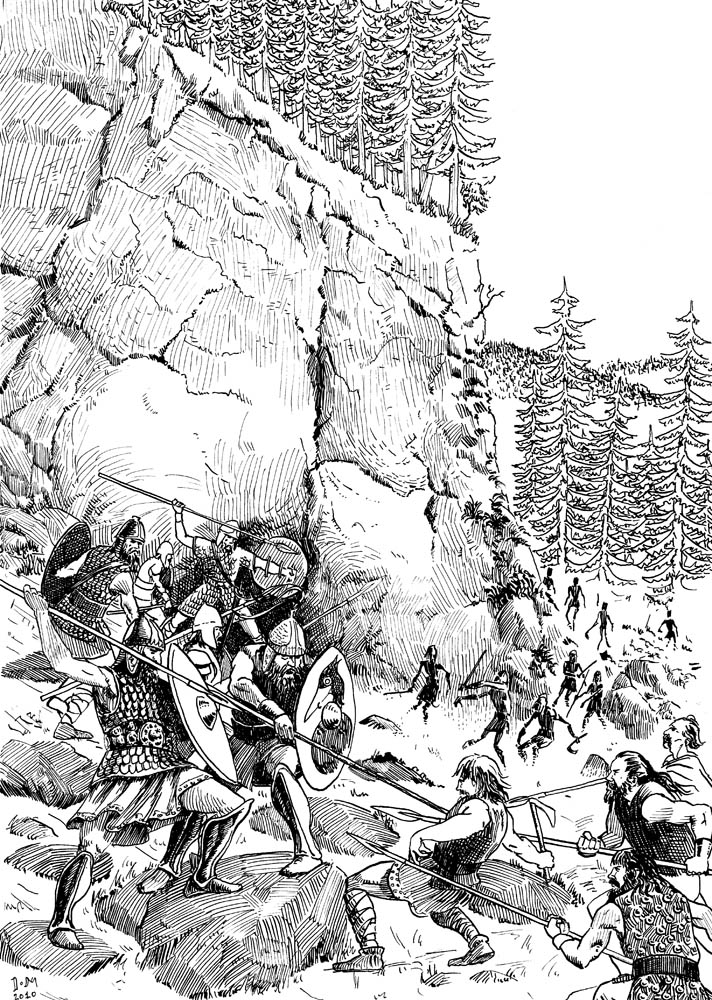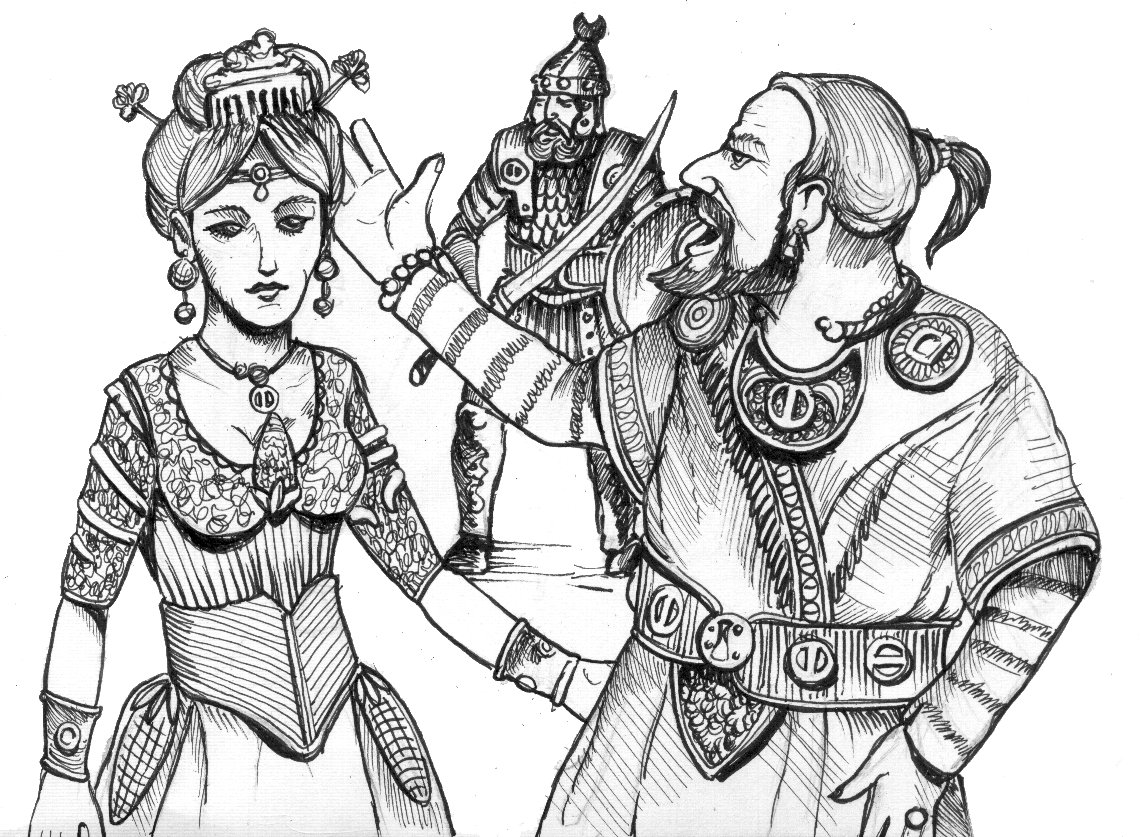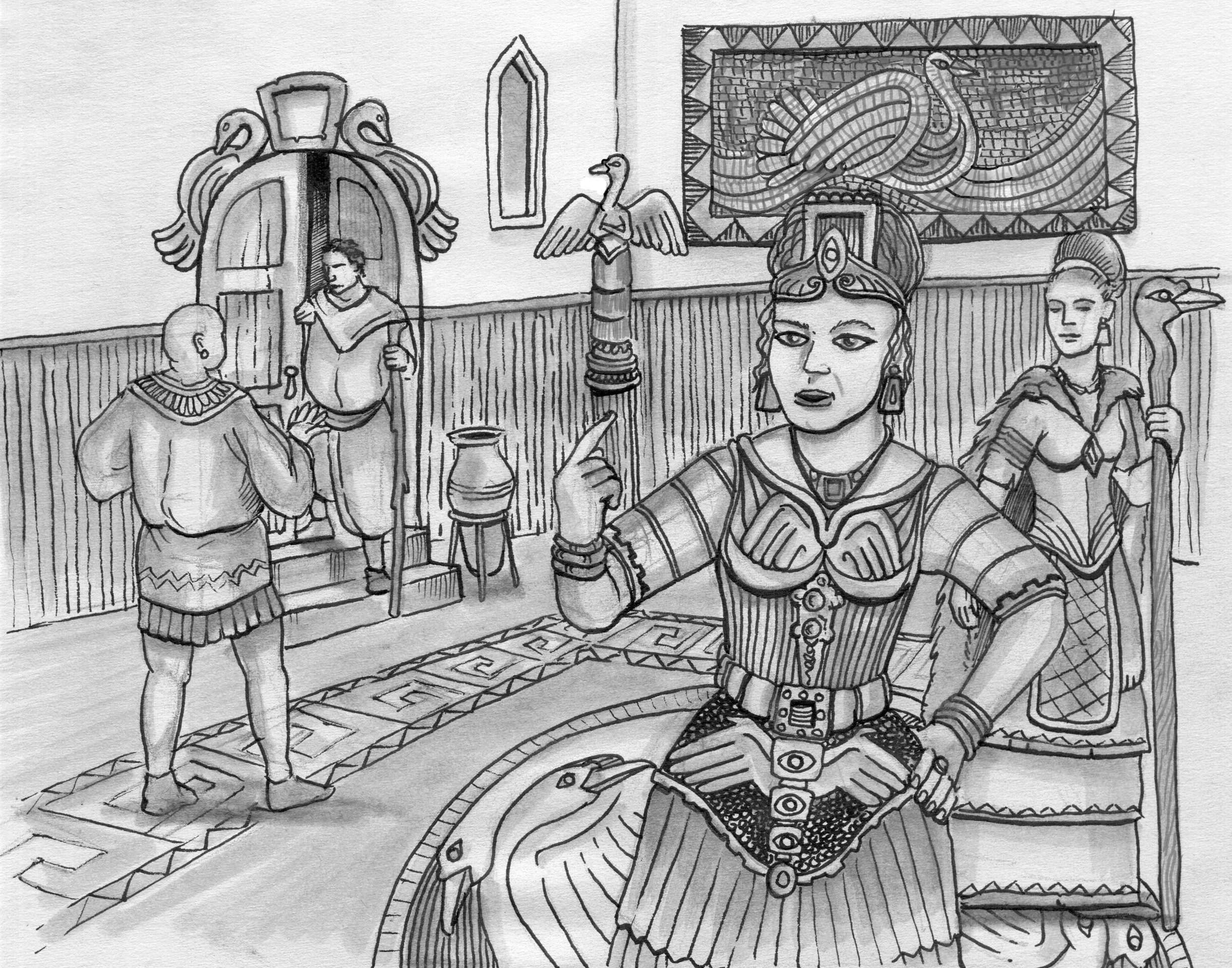Submitted by Jeff on Tue, 29/11/2011 – 13:50
The Orlanthi are one of the four Major Cultures of Genertela (along with Westerner, Pelorian, and Vithelan). All Orlanthi share a few common features:
- the clan (an extended kinship group based on actual or claimed descent from a common ancestor) is the basic unit of social organization;
- Orlanth is acknowledged as a Storm King and Lightbringer (although not necessarily the most locally important god);
- Ernalda is worshipped as a senior Earth Goddess (although not necessarily the most locally important goddess);
- both are tightly (if sometimes seemingly inexplicably) linked;
- the Orlanthi pantheon is worshipped, give or take some members;
- Sacred Time is is a period of constant ritual and magic; and
- literacy exists, but is typically confined to a priestly sect.

Beyond these 7 common features, there is room for significant diversity within the Orlanthi culture.
In general, most Orlanthi cultures can be compared to a mish-mash of Late Bronze Age, early Iron Age historical cultures. Combine heroic Mycenaean Greeks with Hallstatt Celts and pre-Roman Italians, and add some Hittite influences and some bits from the Rigveda, and add some flying, thunder and lightning wielding, warrior-magicians and you won’t be far off.

What the Orlanthi are not: British Celts with spiky hair, Scottish Highlanders, or Vikings.
Dragon Pass: Think Switzerland or the Tirol inhabited by feuding Afghan tribes and you won’t be far off. The Storm Gods are very powerful here, and as a result, the weather is often exaggerated, with sunny summer days that end in terrible thunder storms, and snowy and cold winters that are chased of with lots of rain. The defining geographical feature is Kero Fin: take Mount Rainier, put another Mount Rainier on top of it, then put another on that – a gigantic icicle some 40,000 feet tall. On a sunny day, you can see it from anywhere until air visibility blurs it out (remember Glorantha is flat).

Tarsh: most of the farmers are Orlanthi, but the rulers are Lunars or imitate Lunar ways. The city of Furthest is a Lunar colony, where New Pelorian is spoken and alien gods worshiped. Think Gallo-Roman Lyons or Romano-German Cologne. Furthest is the very end of Lunar civilization – beyond it, here be monsters! Outside of the Lunar settlements, life goes on for most Orlanthi as before, although Orlanth is largely pushed behind the scenes in favor of celebrating Barntar and his mother Ernalda.
Tarsh Exiles: Very traditionalist, old-school Orlanthi who fight off the Lunars with their bloody Earthquake Goddess Maran Gor. They live in rugged mountains around Kero Fin and have maintained their independence at a great price.
Sartarites and Hendriki: Filled with fanatical Orlanthi who will die for their right to sacrifice cows and sheep for their beloved Storm King. Despite this, there is a surprisingly urban culture in Sartar, with three significant market towns, and the capital Boldhome is large city high in the mountains held in common by all the tribes. The Hendrikings are the same people as the Sartarites, but look to their sacred temple-fortress of Whitewall instead of Boldhome.
Malkonwal: This is an Orlanthi land ruled by a Western wizard-warrior adventurer who installed himself as King with the aid of a bunch of Westernized Orlanthi (or is it Orlanthized Westerners?). The ruler is personally powerful, but doesn’t have any deep popular support and his kingdom lasts about three years. Something like William Walker (who briefly conquered Nicaragua with 160 mercenaries from the States and about 170 locals) or Roussel de Bailleul (who briefly carved out an independent state in Galatia with the aid of mercenaries) or a less successful King Conan of Aquilonia!
What this is not: Malkonwal is not the a Rokari version of the Kingdom of Jerusalem, with anti-pagan inquisitors and the like (the kingdom ultimately lasts about three years) – Rikard is not even Rokari (he’s from the Castle Coast)!

Esrolia: This is a rich and powerful Orlanthi land ruled by the Grandmothers of the clans, who usurped the authority of the Sons of Orlanth in the Great Darkness in order to survive: the Grandmothers fear and dread the return of an heir to the ancient kings (think the Stewards of Gondor but with more fear). The title “Grandmother” refers to the head of an Esrolian matrilineal family or clan. The Grandmothers have absolute authority over the members of their family. Cities are ruled by queens elected by the grandmothers. However, traditional Orlanthi masculine roles are maintained: men work in the fields and defend their farms and families; women raise children and run the household.
A shockingly rich profusion of Earth deities can be found here and Ernalda is revered as the Queen of the Universe – the feminine powers of the world are celebrated with great enthusiasm. Orlanth is acknowledged but his cult is downplayed by the Grandmothers (but Esrolia is still revered by the Orlanth cult of surrounding lands). Nochet is the center of the Grandmothers’ power; the temple-city of Ezel (the home of Ernalda) is ruled by the Ernalda priestesses. Put the Knossos of Sir Arthur Evans in Provence or Lombardy and you won’t be far off.

What this is not: A dystopian Egyptian gynocracy with eunuchs, and sacrificial Year Kings.
Caladraland: This is a volcanic land with jungles and volcano priests. They *are* Orlanthi, but their primary religion is appeasing the Volcano God Veskarthan and his brood. So they are Fire (but not Sky) worshipping Orlanthi who live in a sub-tropical climate – and probably stretch the definition of Orlanthi as broadly as you possibly can. Barntar is the agricultural god in the northern river valleys of Vinavale and Porthameka, but in the jungles they do it differently (slash and burn with a hoe). They have surprisingly good weapons, armor, and other crafts thanks to their ancient friendly relationship with the dwarfs of Gemborg.
Submitted by Jeff Richard (not verified) on Wed, 07/03/2012 – 18:45.
YGWV! But you are unlikely to see any forthcoming material or art publish that reinforces that. So if you want to tell your players that the Orlanthi are British Celts with spiky hair, they might be disappointed that none of the pictures of them in the Guide (frex) reflect that. Or that there is no mention at all about “Year Kings” in the lengthy Esrolia writeup in the same book.
Submitted by iskallor (not verified) on Wed, 07/03/2012 – 18:39.
What the Orlanthi are not: British Celts with spiky hair, Scottish Highlanders, or Vikings.
What this is not: Malkonwal is not the a Rokari version of the Kingdom of Jerusalem, with anti-pagan inquisitors and the like (the kingdom ultimately lasts about three years) – Rikard is not even Rokari (he’s from the Castle Coast)!
What this is not: A dystopian Egyptian gynocracy with eunuchs, and sacrificial Year Kings.
Unless you want it to be…….
Submitted by Barbar (not verified) on Wed, 30/11/2011 – 03:31.
This is great! I’d love to see more of this kind of summaries (with pictures too, if possible). 🙂
Submitted by Jeff Richard (not verified) on Tue, 29/11/2011 – 20:39.
I should make it clear, this is a quick overview of the look and feel of various Gloranthan cultures, not a detailed bit of deep background. YGWV, but future books are likely to reflect this. If you want Rikard to be a nasty bastard Rokari who suppressed all pagan activity in his brief rule, you certain can. But that is not going to be the version of Rikard who makes it into future books. Personally I think the version that Greg and I have come up with is plenty fun…..
Submitted by David Dunham (not verified) on Tue, 29/11/2011 – 20:28.
Balts were a model for my Anadikki Orlanthi…
Submitted by Paolo Guccione (not verified) on Tue, 29/11/2011 – 19:21.
Really good, indeed. This was needed. Many people ask “where to start with Glorantha”, and they are often directed to a compendium/cyclopedia kind of book that ultimately scares them. Articles such as this give you a good idea of what you can expect in a typical Orlanthi game.
Just one note: I do not want to insert subliminal advertising, but actually the ancient Balts are a very good Earth parallel for the Orlanthi. They were a culture with stunning resemblance to pre-Roman Italians that survived into the late Middle Ages, and their favorite pastime was raiding their neighbours. The only problem is that few people know the ancient Balts, so you cannot use them as a way to clarify what Orlanthi are supposed to be.
Submitted by Joerg Baumgartner (not verified) on Tue, 29/11/2011 – 17:35.
New Malkonwal is headed by Rikard, a mercenary who became king. He may not have been a Rokari, but some of his followers may have been, and some may have had that idea.
I usually use sets of sympathic occpators vs unsympathic occupators, and the same for occupied people. Thus when I played around with Heortland between the disappearance of the Pharaoh and the Fall of Whitewall, I took pains to provide both villains and possible allies within all of these factions (and also the possibility to ally a villain, of course).
So, as far as my Glorantha is concerned, “what it is not” is read as “what it is not in the general overview, but can be in the specific case”. It is a shame to ignore those plot hooks if they work for your game. There have been sacrificial kings in Esrolia, there may be an undead grandmother ruling a family, there have been Rokari lords in Heortland suppressing all pagan activities (possibly more so after swearing allegiance to the Lunars after Rikard lost against Fazzur).
I miss the point that the Grandmothers are followers of Imarja rather than the good goddesses of Ezel. They are quite outside of the Orlanthi norm.
And there is no statement about the Pelaskites. Those of the Rightarm Isles are as variant from standard Orlanthi as are the Caladralanders, those of the inner coast would be more standard.
Related Pages
Page Last updated: 2025-09-08 13:12:53
